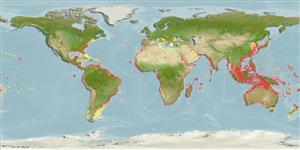Environment: milieu / climate zone / depth range / distribution range
Ecology
Marine; brackish; benthopelagic; oceanodromous (Ref. 51243); depth range 0 - 70 m (Ref. 86942), usually 0 - 70 m (Ref. 55224). Subtropical; 45°N - 53°S, 98°W - 154°W (Ref. 55224)
Tropical and subtropical waters of all oceans. Western Atlantic: New England and Bermuda southward to Argentina (Ref. 114270); and Falkland Islands (Ref. 114522). Eastern Atlantic: presumably along the coast from the Straits of Gibraltar to the Gulf of Guinea, including Madeira, although reliable records still lacking from Angola, the Canary Islands, and Cape Verde Islands; and Mediterranean (Ref. 114272). Indo-Pacific: East Africa through all countries of Southeast Asia north to Taiwan Province of China and southern Japan, northern Australia to southern Queensland, New Guinea to New Britain, and south to Fiji. Reported as rare visitors in Ponape, Hawaii, and Tahiti (Ref. 47694). Records from eastern central to southeastern Pacific need further confirmation and may refer to Lobotes pacificus.
Size / Weight / Age
Maturity: Lm ? range ? - ? cm
Max length : 110 cm TL male/unsexed; (Ref. 7251); common length : 80.0 cm TL male/unsexed; (Ref. 5450); max. published weight: 19.2 kg (Ref. 40637)
Dorsal spines (total): 11 - 12; Dorsal soft rays (total): 15 - 16; Anal spines: 3; Anal soft rays: 11 - 12. Adults dark brown or greenish yellow above, silvery grey below; pectorals pale yellow, other fins darker than body; caudal fin with yellow margin (Ref. 4386). Rounded caudal fin that appear as single 3-lobed fin (Ref. 26938).
Adult inhabits bays (Ref. 37816), muddy estuaries and lower reaches of large rivers (Ref. 48636). A sluggish offshore fish that often floats on its side near the surface in the company of floating objects. Occasionally drifts over reefs (Ref. 9710, 44187). Juvenile may occur in floating Sargassum and mimic a floating leaf (Ref. 37816). Feeds on benthic crustaceans and small fish (Ref. 30573, 44187). Marketed fresh, frozen, or salted.
Life cycle and mating behavior
Maturity | Reproduction | Spawning | Eggs | Fecundity | Larvae
Tortonese, E., 1990. Lobotidae. p. 780. In J.C. Quero, J.C. Hureau, C. Karrer, A. Post and L. Saldanha (eds.) Check-list of the fishes of the eastern tropical Atlantic (CLOFETA). JNICT, Lisbon; SEI, Paris; and UNESCO, Paris. Vol. 2. (Ref. 6947)
IUCN Red List Status (Ref. 130435: Version 2024-1)
Threat to humans
Harmless
Human uses
Fisheries: commercial; gamefish: yes; aquarium: commercial
Tools
Special reports
Download XML
Internet sources
Estimates based on models
Preferred temperature (Ref.
123201): 18.3 - 29, mean 27.4 °C (based on 5946 cells).
Phylogenetic diversity index (Ref.
82804): PD
50 = 1.0000 [Uniqueness, from 0.5 = low to 2.0 = high].
Bayesian length-weight: a=0.02630 (0.01424 - 0.04859), b=3.01 (2.84 - 3.18), in cm total length, based on LWR estimates for this species & (Sub)family-body (Ref.
93245).
Trophic level (Ref.
69278): 4.0 ±0.5 se; based on diet studies.
Resilience (Ref.
120179): High, minimum population doubling time less than 15 months (K>0.5; tm=1).
Prior r = 0.86, 95% CL = 0.57 - 1.28, Based on 1 data-limited stock assessment.
Fishing Vulnerability (Ref.
59153): Low to moderate vulnerability (34 of 100).
Climate Vulnerability (Ref.
125649): High to very high vulnerability (67 of 100).
Nutrients (Ref.
124155): Calcium = 40.9 [22.2, 78.7] mg/100g; Iron = 0.898 [0.479, 1.629] mg/100g; Protein = 18.8 [17.8, 19.8] %; Omega3 = 0.268 [0.148, 0.487] g/100g; Selenium = 38.5 [19.2, 86.9] μg/100g; VitaminA = 6.77 [1.92, 27.07] μg/100g; Zinc = 0.522 [0.349, 0.798] mg/100g (wet weight);
